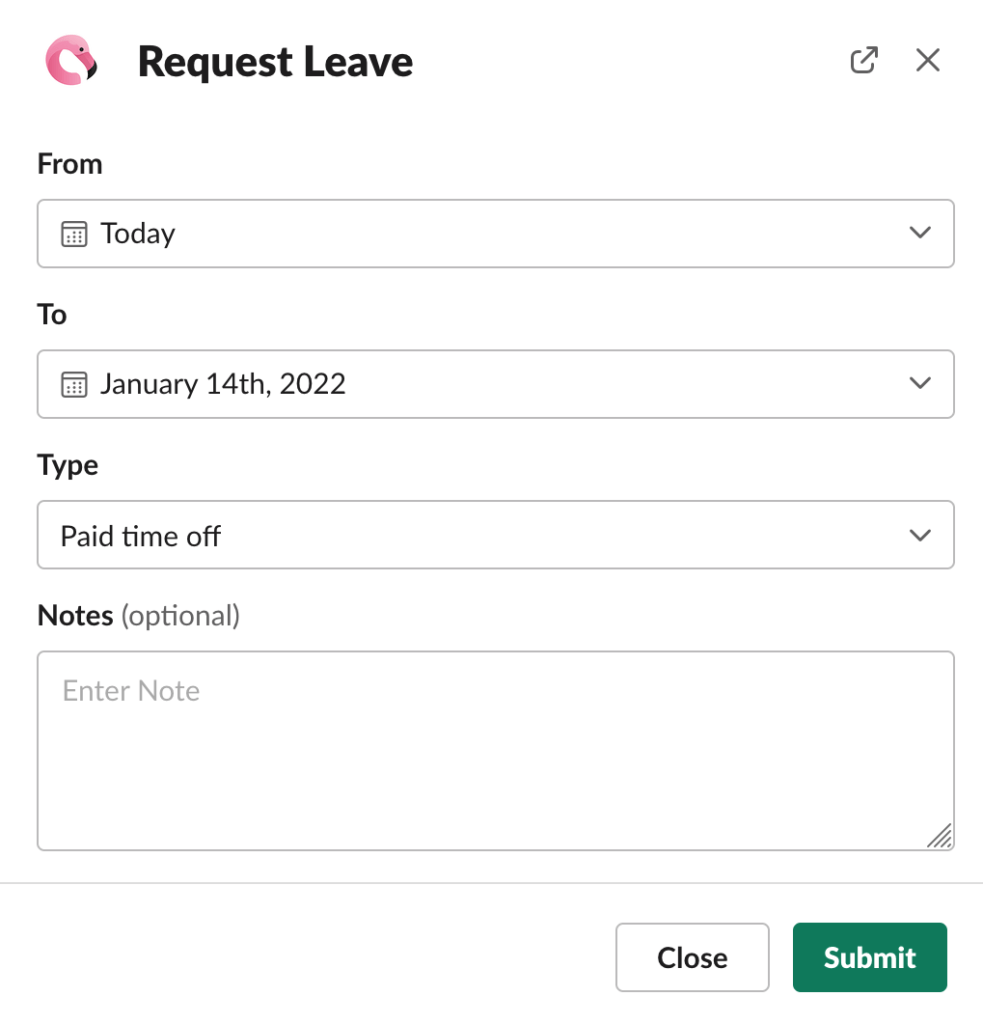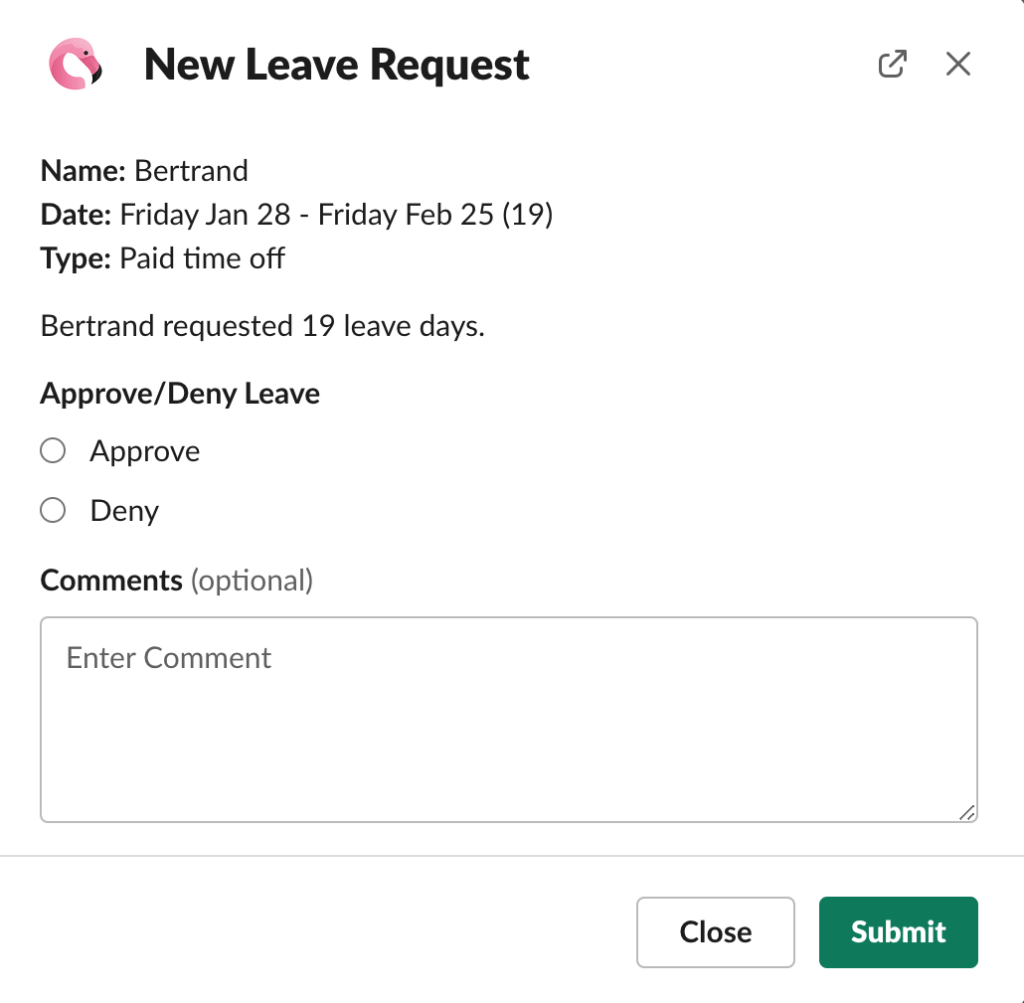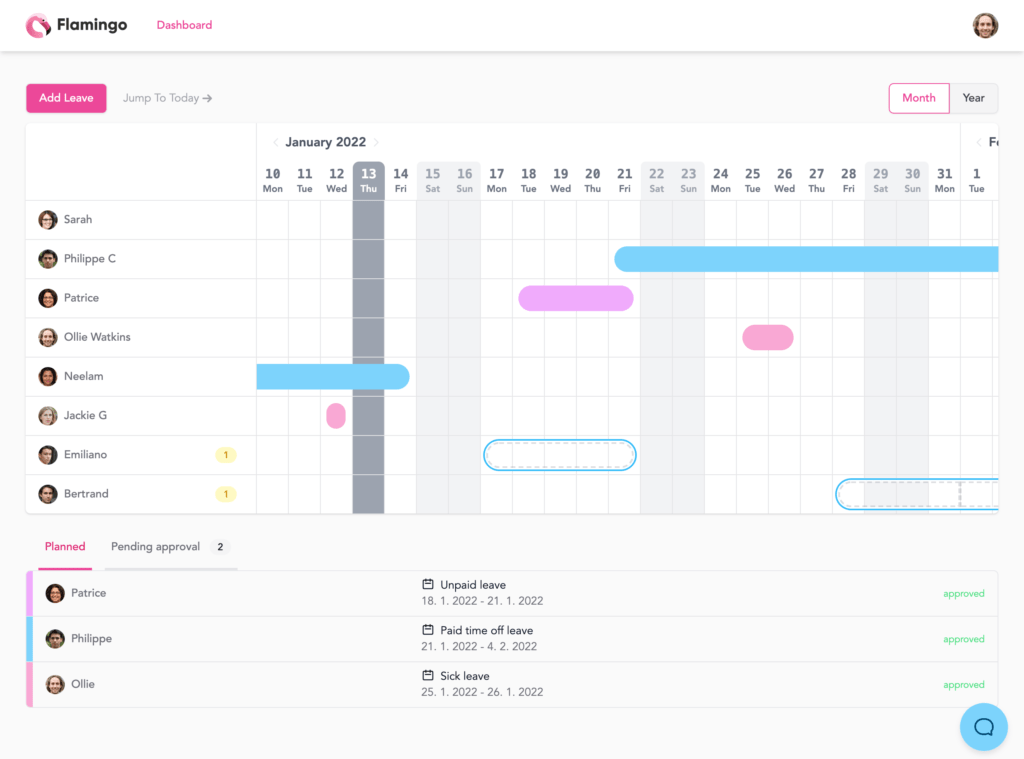November 18, 2024
Presenteeism: The $150 Billion Problem for Modern Businesses
What if your organization is losing more productive hours from employees showing up than from those staying h...
The way you set up and run your leave management system has a huge impact on your company’s efficiency and productivity.
Like it or not, team members are going to need to take leave (time off from work) at some point. It could be forced (such as sick leave, maternity or paternity, or bereavement leave) or voluntary (i.e. vacation). Either way, the business needs to be prepared.
Your leave management system is the set of processes and procedures that ensure there’s no disruption to productivity whenever staff are away. To learn more, and learn how to set up an effective system in your business, keep reading.
A leave management system is the the set of processes, procedures and tools your business uses to manage employees’ time off.
This includes how leave requests are made, how requests are approved or denied, and what happens when an employee goes on leave.
Here are a few things that come under the umbrella of leave management:
What sounds simple at first can easily grow out of control as your team gets bigger, or as certain edge cases come up, which is why it’s important to set up a fool-proof leave management system as soon as possible.
Related Article: A complete guide to effective leave management for remote teams.
When your leave management system works well, you’re going to be less likely to come up against disruptions when employees take time off.
Nailing this process will produce benefits that carry over to the rest of your organization.
Here’s a summary of the top benefits from a great leave management system:
HR staff, managers or business owners often spend far too much time managing leave – from handling leave requests to managing the schedule when someone’s off work.
Good leave management systems will take a lot of this painful busywork out of the hands of humans, and automate it. This will save time for key management staff, and free them up to work on task that move the business forward.
One of the headaches managers face with managing leave is keeping the schedule running and avoiding issues of short-staffing when someone’s away.
Systematizing your leave management should include a simple way to maintain your holiday calendar and ensure it’s easy to see who’s available at any given time.
Every business at some point is likely to run into compliance issues. This means making sure your business adheres to all relevant rules and regulations (leave laws, for example).
If you run your business (particularly HR management practices) by the seat of your pants, you’re inviting serious compliance risk. But leave management systems make it easier to put a set of rules in place so you never run the danger of breaking chain of compliance.
If your leave management solution doesn’t ensure all relevant labor laws are adhered to, you can risk legal action, which can cost millions.
Additionally, your system will provide a greater level of transparency, by adhering to standard processes that remove any question of bias or unfairness.
Employees are happier when they have the option to take time off from work. And making it an easy and transparent process to request leave doubles that.
If you make it easy for people to take their allotted leave days, you’re going to get a positive, happier environment, and team members will be more refreshed and ready to come into work and give their best.
Attendance tracking and identifying trends is a big part of effective leave management.
A leave management system will help you notice absence trends, such as employees who display signs of absenteeism. You can also pick out those employees who don’t take leave often enough, and who may be at risk of burnout.
This is even easier if you use a leave management software, which can give you data on employee leave history and patterns at the click of a button.
When we’re talking about a leave management system, software tools are not necessarily a requirement. It’s possible to have a leave management system in place that doesn’t involve any kind of app or tool.
For example, your system could look like this:
That’s a system. And it’s better than having no plan for how you’re going to manage your employee time off workflow. However, it’s likely not going to work as well as an automated leave management system (i.e. a software tool).
A leave management software is much more efficient. You’re going to save time you’d otherwise spend on data entry and manual data lookup. By automating this data entry, you’re also going to get fewer mistakes due to human error.
You can to do more complex things with a software tool, than you could with a manual system, such as integrating with other tools or parts of your workflow.
Leave management software tools often provide an employee self service portal for people to ask for leave, which is another big benefit, reducing friction and making it easier to take time off.
All in all, the time savings and quality of life improvements of using a leave management software are worth much, much more than the cost of the tool, in most cases. So it makes little sense not to take advantage of software to set up your leave management system.
Further Reading: The Best Slack Apps & Integrations to help you level up your team in 2024.
Whether you use a leave management software tool, or set up a manual system, it needs to have a few features to run smoothly.
A good leave management system should be simple, which is often easier said than done.
At the same time, you need to make sure it helps you lower the impact on productivity when employees are away from work, as well as helping you identify and take action on trends.
Finding the right balance between power and simplicity is the key.
Here are some things to include as part of your system.
Your leave tracking system would ideally integrate with tools you’re already using, like Slack, Microsoft Teams, etc.
For example, it would make sense to have leave requests and approvals happen inside Slack, if you’re already using it to communicate, share files, etc.
This keeps things simple, and cuts down the time your staff need to spend switching between different tools.
A leave tracking system should provide a calendar view that combines the absence schedules of all team members across the organization.
Being able to see an organization-wide leave calendar provides real-time information about staff availability during the coming weeks and months.
Understanding your team’s availability will help you plan production schedules, as well as other business operations.
For international teams, the calendar should include local holidays in each country so you can plan for any absences in advance.
Your leave management system should also integrate with external calendar tools you use in your company.
A lot of people run their daily schedule through their calendar (e.g. Google Calendar, Outlook, or Apple Calendar).
Integrating upcoming leaves with your calendar will make it easier to stay on top of the schedule.
One of they key features of an automated leave management system is being easy to use.
Team members should be able to check how many leave days they have remaining, and use a quick and simple process to put in time off requests.
The process should be equally simple for HR to manage leaves. They should be able to view the team member’s profile, who else is on leave on the requested days, and make a decision to approve/deny the request.
The workflow should be simple, efficient, and eliminate paperwork and unnecessary admin tasks.
Your online leave management system should have a way to notify the team and keep everyone up-to-date with scheduled leaves and holidays.
This will help everyone plan their work in advance, prevent unexpected disruptions to workflow.
This could come in the form of a calendar view of scheduled leaves, visible across the entire company, or regular notifications sent to a Slack channel about upcoming leaves.
Depending on your company’s time off policy, and sometimes local labor laws, you might provide different leave types. Sick days, unpaid leave, parental leave, paid time off (PTO), and vacation days are some examples.
Your system should allow for this, by letting you customize your leave types and set up custom leave policies.
You might have separate leave policies for your business’ different locations, and you’d want to be able to tailor your system accordingly.
Detailed reports help you identify trends within your team and understand your employee’s needs better.
You might find that your team members are taking too few days off, which could potentially lead to burnout and affect performance. On the other hand, you might find certain employees have a tendency for absenteeism, and that you might need to find new ways to motivate them.
Ideally, you’d be able to generate reports within your system and then export them as CSV files.
Finally, your leave tracking system should allow you to create a profile for each team member.
The profile should show the remaining leave balances for each person, as well as the overall number of leave days they have.
HR staff should be able to access employee profiles easily to check how many leave days they have available before approving (or denying) employee time off requests.
A lot of companies don’t like employees going on leave. It’s the mark of a good employee – attendance.
On the surface, it makes sense. You don’t like paying people not to work, right?
Again, this is an upfront cost that can save the business a lot of long-term expense.
When people come into work when they’re sick or burned out, they’re less productive. Even worse, they remain at this lower level of productivity for longer, since they don’t get the time they need to rest and recover.
This problem is estimated to cost $150-$200 billion in lost productive hours for U.S. businesses. In comparison, the cost of allowing employees to take regular vacations and paid sick leave is minuscule.
Furthermore, the cost of disengaged employees at work is estimated to be as high as $550 billion per year. This is often simply a case of overworked team members, and massive costs can be avoided by simply being generous with paid leave and vacations.
Further Reading:
The issue where employees come into work is a phenomenon known as presenteeism. Presenteeism is an under-appreciated and poorly understood problem in business circles, which creates significant long-term problems and costs. Click the link above to learn more about this issue and how to avoid it in your company.
Many small to medium businesses are still using some combination of email, private messages, face to face discussions, paper forms and/or spreadsheets to manage their leave tracking process.
This is enormously inefficient, time consuming and error-prone.
The best way to manage leave in your business is with a leave management software like Flamingo.
This removes 90% of the unproductive busywork of managing leave, and significantly reduces the chance of human error.
Leave request and approval workflows with Flamingo take less than ten seconds on each side. There’s a simple leave request form for the employee to fill out when they need a day off, which is automatically sent to their manager for review.


The app then adds all approved and pending leaves to the team-wide vacation calendar for easy scheduling.

This is a streamlined, “set and forget” way to manage time off requests and the approval workflow, and create less work for the HR department or team managers.
Flamingo’s automated leave management system also features:
You’ll do everything inside Slack. Leave requests and approvals even work inside the Slack mobile app, allowing you to manage leaves on the go.
With Flamingo’s affordable monthly subscription, you can easily set up a team holiday management workflow on Slack.
For larger companies, our HR software offers predictable pricing that scales with your business, so it always provides value relevant to your business.
Too often, leave management involves inefficient, time-consuming and error-prone processes that hurt productivity.
An online leave management system is a better HR solution, automating the busywork and freeing up your valuable time.
Investing in a time off management software like Flamingo could be the best decision your team ever makes.
Flamingo® makes managing your team’s paid time off a breeze.